The war in Ukraine didn’t start on February 24, it started with the Euromaidan riots, on November 21, 2013.
Ukraine’s leadership nixed an agreement with the European Union that would have brought the two closer, in favor of Russian ties. The response was a militarized riot that brought about a pro-Western political revolution and led to counter action in the east in the form of pro-Russian separatism in Donbas and the invasion of Crimea by Russia. The underlying tensions simmered ever since, erupting this year in Russia’s military action against Ukraine.
This series of events shows how street warfare – organized riots with concrete political objectives – are as geopolitically impactful as open military conflict. The effectiveness of street warfare like Euromaidan can be seen in its increasing proliferation. The year 2018 was marked by the beginning of the Gazan border riots, and 2020 and 2021 saw US Antifa riots and the January 6 Capitol riots.
Warfare is constantly evolving and the doctrines of street warfare are no different. As it develops, it is useful to identify the strategies and tactics to understand how it is conducted against authoritarian regimes and for democracies to prepare for its use by malicious radicals.
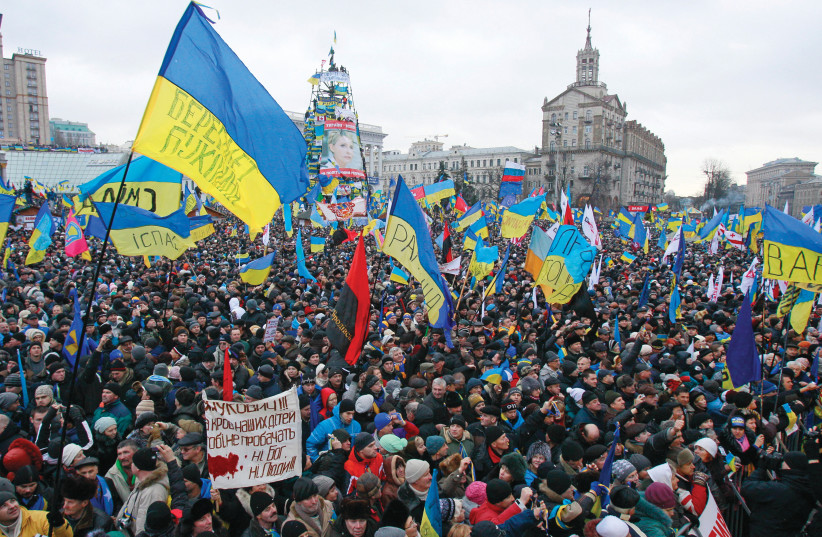
What is street warfare?
While there is confusion and dispute about the terms, typically, protest is used to describe a peaceful organized political or social awareness demonstration by citizens.
In contrast, riots are mass uncontrolled violent outbursts. They may start over anything from sports to politics; however, they aren’t directed toward achieving a specific political objective. Street warfare, or organized riots, are low-intensity conflicts in which planning, strategy and tactics utilize mass street violence to achieve political goals.
“What make Antifa riots different from and more significant than football riots is that the violence is organized under extremist political ideology and has a political agenda, where rioting is actually used as one of the means to try to achieve goals,” Andy Ngo, a journalist who documents far left-wing violence and radicalism, told The Jerusalem Post Magazine.
<br>What movements use organized riots?
Hamas, Antifa and right-wing extremists have all used organized riots in recent years.
In 2019, Gazan activists began to engage in mass marches on Israel’s border. While the protests were initially grassroots activism, Hamas soon saw their potential and took them over.
In 2020, the Antifa movement began to undertake a new level of action in streets across the US, which eventually allowed some to seize territory, such as the Capitol Hill Autonomous Zone (CHAZ). These were larger territorial occupations than in Euromaidan.
“They very strategically hitched themselves onto the Black Lives Matter protest and had a very big role in helping to turn many of those protests into riots,” Ngo explained.
On January 6, 2021, a mob of rioters at the Capitol tried to interfere with the election’s outcome. While the riot was not as well directed as other examples, it shows how the far-right may be adopting street warfare tactics to further political goals.
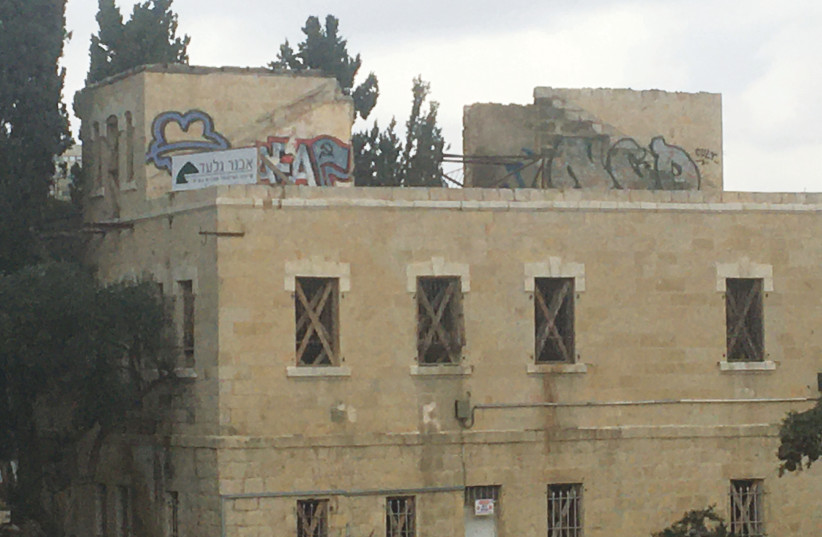
<br>Why use organized riots?
Street warfare, like other political violence, is used to force and pressure authorities into accepting policies and demands.
As well, it can be used in a more complicated strategy, seeking what Dr. Liram Koblentz-Stenzler, head of the global far-right extremism desk at ICT, calls the acceleration event.
Some radicals want to accelerate the collapse of the current social order and allow the rise of a new social order, which will serve the interests of their movement. To achieve either, the authorities must be discredited.
In “Why Break Windows” by an Antifa supporting revolutionary collective called Crimethinc, they explain that property damage “can mobilize potential comrades by demonstrating that the ruling forces are not invincible.”
The Gaza border riots were in part Hamas’ way of discrediting Israel.
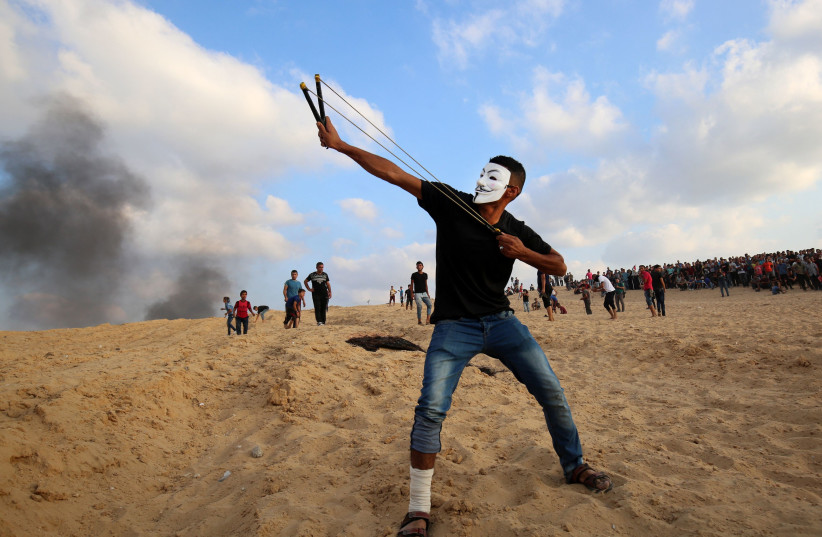
“Even if one person gets across [the security barrier], it could send a message that ‘actually this barrier means nothing to us,’” said Ido Levy, associate fellow at the Washington Institute For Near East Policy.
An important factor of discrediting and demoralizing authorities is to manipulate the media and use propaganda.
“Long before an action, when you are establishing and prioritizing goals, work out exactly how much media coverage you want, from which sources, and how you are going to obtain or avoid it,” reads Crimethinc’s direct action guide.
Levy argues that the deceptive appearance of Hamas riots wins over the media. “The demonstrations make it seem like they’re just unarmed civilians.”
It’s this false image that makes it effective for these movements to use organized riots rather than terrorism.
In Ngo’s book Antifa Unmasked, he relates what writer Erin Smith describes as calibrated violence, in which authorities are forced into a dilemma of action by organized riots: If they don’t respond they look weak; if they react they seem to observers as overreacting. Both options discredit authorities.
“Hamas and others understand that when there are women and old people as part of those events, the IDF will not take action,” said Brig.-Gen. (res.) Nitzan Nuriel, fellow at the International Institute for Counter-Terrorism and former director of the Israeli Counter-Terrorism Bureau. “We have to admit that we don’t have a good solution, not only Israel, all over the globe, when 10,000 people decided to walk together and demonstrate. If they want to destroy something, they will destroy it.
<br>Planning, logistics and communications for street warfare
What separates a riot from a militarized riot is the high degree of preparation.
Crimethinc’s article “A Step-by-Step Guide to Direct Action” emphasizes the importance of planning: “Proper planning is the essence of safe, effective direct action.” The article advises how to establish objectives, picking “the most effective tactics in the context of the current social and political situation.” Activists are advised to run through multiple scenarios and develop operation timelines, just as with any military operation.
Movements conduct field intelligence to understand potential operational challenges.
“Before the action, study the area carefully,” advises Crimethinc. “Chart safe routes in and out; look for hiding places, obstacles, potential targets, and surveillance cameras.”
These movements even conduct field intelligence against other riot organizers.
During the George Floyd protests, “white supremacists also followed the protests, in many cases to try to organize or to push counter protests,” said Dr. Ariel Koch, a specialist on transnational violent extremist ideologies and movements, and a postdoctoral researcher at Reichman University.
“You can see in anarchist chatter how they mobilize supporters to confront Patriot Front [a white supremacist group] members by following Patriot Front, reporting the streets where they are going and where they are moving, and calling others to block them or to arrange a counter protest,” Koch also said.
To coordinate, movements have developed communication procedures during planning and in the field.
Crimethinc advises to “use communication systems such as burner phones, encrypted text messaging, two-way radios or whistles to keep in touch; audio or visual signals such as car horns or fireworks can also serve.”
Koblent-Stenzler explained how some right-wing extremists have adopted coded language, “We saw that they created a video game jargon. They are using terms that are taken from video games such as Minecraft, Call of Duty, or Roblox, to represent actions... For example, if a person says that he wants to collect as many diamonds as possible, he isn’t talking about diamonds in the video game, but about people he wants to kill.”
This operational security goes beyond coded language. Many movements practice what is known as black bloc.
“You wear all black, cover your face, hide your identity. You have no identity. You are part of something bigger,” Koch explains. This creates anonymity, solidarity and hinders legal action.
White supremacists are advised “to wear long sleeves because you don’t want other people to identify you if they see a tattoo,” said Koblent-Stenzler.
“Cover your whole face, not just your mouth,” advises Crimethinc. “There should be no visible logos on your clothes, shoes or backpack.”
The most difficult aspect of logistics can be transport and supply lines – as the Russian invasion of Ukraine has reminded the world.
Hamas organized buses to riot sites, ensuring people would arrive and according to Nuriel, supplied rioters with water and Wifi.
During Antifa riots, “There are people who are setting up tables, tents and canopies where you can get food, you can get water, you can get tent supplies. What these things did was create a parallel economy where people were able to supply those who are rioting full time.”
Antifa-affiliated affinity groups are small teams that specialize and can focus on support efforts, such as medical support, food or transport, in the same way that a military force has logistics divisions. In Portland, Riot Ribs fed rioters so that they could continue rioting. An army marches on its stomach, so does a riot army.
<br>Organized riot tactics
Movements that use organized riots consciously employ advanced tactics to achieve their immediate objectives.
This tactical knowledge starts with manuals and sharing best practice.
“We see videos, and the same videos are shared again and again by different players, by different actors,” said Koch. “How to defend yourself from tear gas, from riot police, what formation you need to stand in.”
White supremacists are “using cyberspace in order to share information,” said Koblent-Stenzler. “We can see them recommending reading insurgency books.”
In CHAZ, activists had a table with manuals that “included descriptions, for example, how to overtake a building, how to secure the exits so that police can’t get in, how to use human shields effectively, how to create Molotov cocktails and other firebombs,” said Ngo.
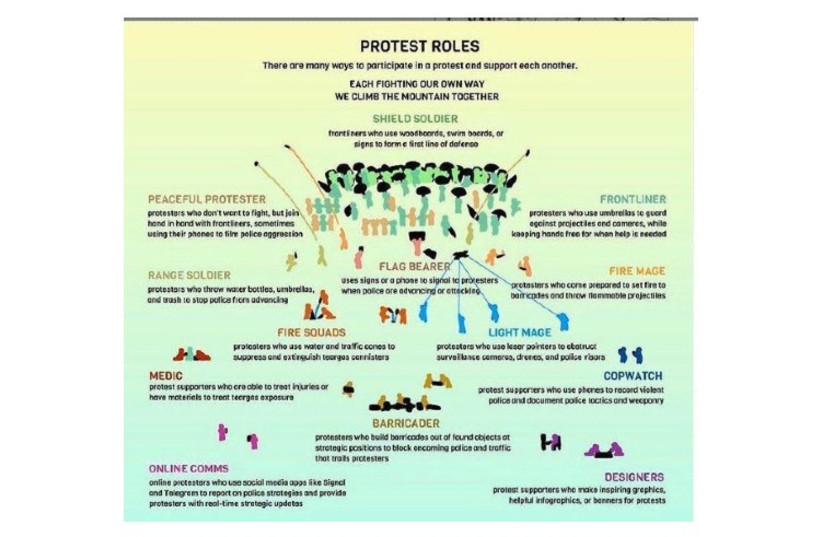
Crimethinc has dozens of tactical and strategic articles and resources on its website to share best practice for direct action. In one such text, it advises participants to conduct debriefings “to discuss what went well and what lessons can be learned,” just as militaries do.
One of Antifa’s lessons is a form of combined arms: “Diversity of tactics is key – not just tolerance for different approaches, but thinking about how to combine all of them into a symbiotic whole,” writes Crimethinc. They also practice specializations, not just of dedicated units like medical teams, but individual roles and weapons that contribute to an overall plan, like scouts or drivers.
Specialization and combined arms can allow for advanced stratagems in the field, such as maneuvers using smokescreens.
In Gaza, “what you would see is they would make a smoke screen with burnt tires and then they would go behind the smoke screens, just start throwing whatever objects they had at IDF soldiers to make it harder to see who’s actually throwing and who’s a civilian,” said Levy.
“At the same time [smokescreens] create more options for launching terrorist cell attack against the soldiers and against villages,” Nuriel noted.
Communication and planning allows rioters to strike multiple locations at the same time, allowing them to divide and conquer.
“Sometimes they will split off into different groups for a particular direct action,” Ngo explained. “One large gathering will do some active mass rioting, such as trying to break inside a police station, whereas a smaller group will go out and carry out another type of violent, destructive activity. Police numbers are too few to be able to respond to both.”
Nuriel said the Gaza riots would often be planned at up to five locations on the border at the same time.
Another strategy that has been implemented in street war are human shields.
Ngo explained how Antifa operatives would embed within peaceful protests, “and engage in violent conduct, such as throwing projectiles at police or breaking out windows. And when police are forced to respond,” the protesters rather than Antifa may be harmed, which also feeds into propaganda efforts.
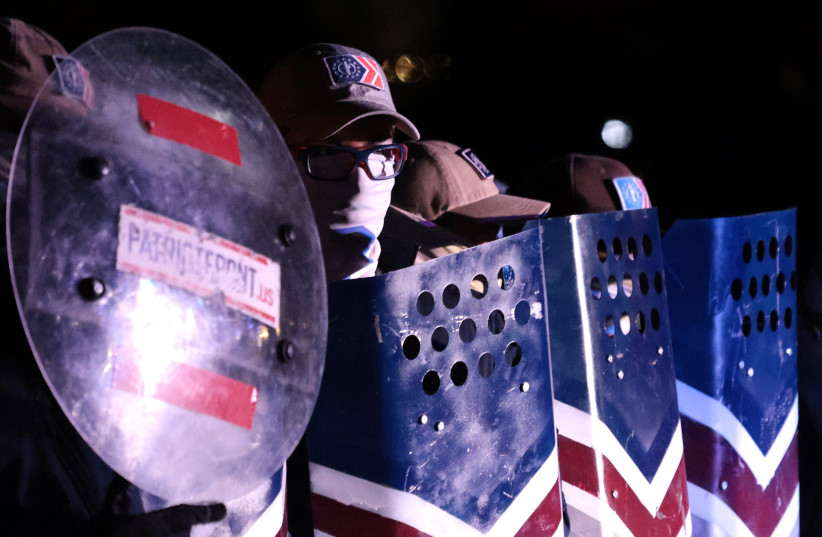
Likewise, Hamas “put armed operatives within crowds of civilians,” said Levy. “Most of the people there seem to really be unarmed civilians that were kind of sent there by Hamas” and are used as shields.
Gazan children, elderly and disabled are moved forward to shield the more violent in the back.
Antifa have also mastered a more ancient form of shield combat, shield walls, to counter police riot measures.
“One of them individually having a shield and standing out, they’re actually quite vulnerable,” explained Ngo. “In practice, they link shields together in formation so that there’s a whole line of shields protecting them and those behind them. The shields also obscure fellow combatants who are preparing projectiles and weapons.”
Antifa and right-wing extremists have reportedly been seen practicing shield formations, showing how training is as important as with a military.
<br>Riot weapons
Rioters have figured out which weapons fit their strategy of calibrated violence and allows them to best utilize their tactics.
Shields aren’t just defensive. “You can strike with it, you can defend yourself with it and you can paint it with your symbol and use it as propaganda,” said Koch. “Doesn’t matter if you’re an anarchist that paints the triple arrows or a Neo-Nazi that paints the Celtic cross.”
Umbrellas, as seen in the Hong Kong protests, can also be used as defensive tools against police munitions or as weapons.
Antifa “would fasten blades to the end of umbrellas,” said Ngo.
Incendiary weapons like Molotov cocktails have long been associated with riots.
It’s one of the “cheapest forms of devastating attacks,” said Koch. “You can set some buildings on fire with gasoline and cause real damage, not only to people but to property.”
During the Gaza riots, there was “increased use of incendiary kites and balloons,” said Levy. These could be launched from within crowds by Hamas’ incendiary kite and balloon unit. Many acres of land have been scorched by these weapons.
Koch notes that neo-Nazi arson is different than other extremist arson, in that “we are talking about people who seek to kill the people who are inside the building.”
Fireworks are also used for similar reasons as Molotov cocktails. They can be used to blind, cause distractions, disorient and cause harm.
“They’ll tape together multiple fireworks, for example, and aim these at a particular target to try to burn them or to throw it into a crowd,” said Ngo.
Lasers have also become a notable tactical weapon, “to disorient police and federal agents. They can also disable security cameras,” writes Crimethinc.
Other weapons commonly used include pepper spray, bear mace, frozen water bottles and paint bombs. While firearms aren’t always used, radicals are often armed. In Portland, extremists have shot ideological opponents several times now.
While Antifa have also used items such as lacrosse sticks to scoop up teargas canisters to throw back at police, Gazan rioters have mastered a better technique: Using slings to throw gas grenades, in addition to their normal munitions of stones.
<br>Can extremists learn from one another?
Generally, radical Left violence is more widespread but less intense; whereas, radical Right violence is high intensity and low saturation.
“The right-wing extremists are much more militant, more violent and full of hatred,” said Koch.
Yet, extremists of all stripes could learn from each other how to conduct better street war.
Koch explained that Neo-Nazis learned black bloc and direct action from anarchists and have even adopted “leaderless resistance, which was more common among anarchists. They have groups or movements that have no leadership,” and are more like networks.
In the process coined by Koch, “fused extremism... one ideology may adopt and introduce into it different aspects from different ideologies and it creates something new.”
“If one concept works for one form of violent extremism, actors in another violent extremist group or movement might also adopt it,” according to Koch.
Street warfare may continue to evolve, becoming more effective and movements like Neo-Nazism or Hamas could embrace it, as much as the radical Left has.
These strategies and tactics can also be used to resist authoritarian regimes.
<br>A continuation of war by other means
As Russia cracks down on protests and dissent in its own territory, we may see residents conduct street wars to forward their political agenda.
Likewise, if Ukraine were to survive Russian predation, it could see extremists like the neo-Nazi Azov Battalion repeat Euromaidan with the objective of implementing more radical political change in Ukraine.
Carl von Clausewitz asserted that war is a continuation of politics by other means. In the same way, organized riots are a continuation of war by other means. There is a political agenda to be achieved and unless one recognizes the seriousness of such acts, one may find that they’ve lost the battle before they’ve even realized it has begun.
